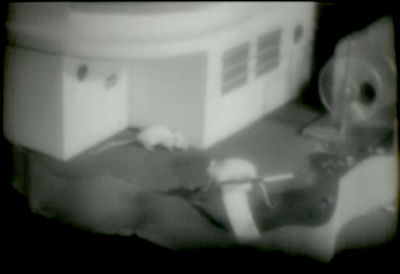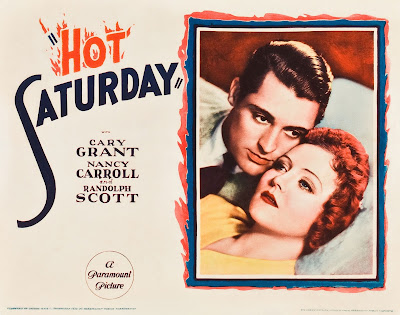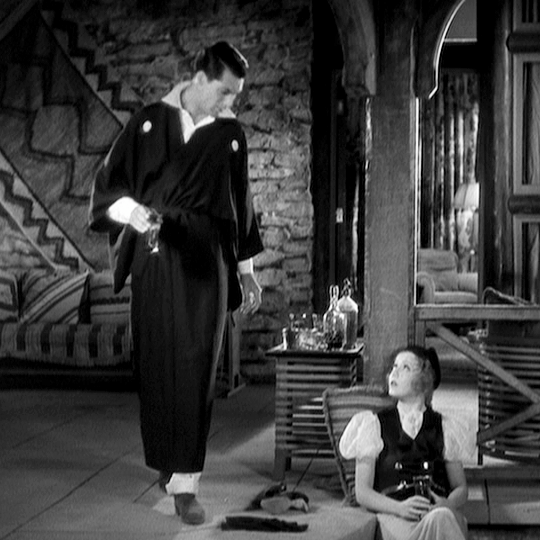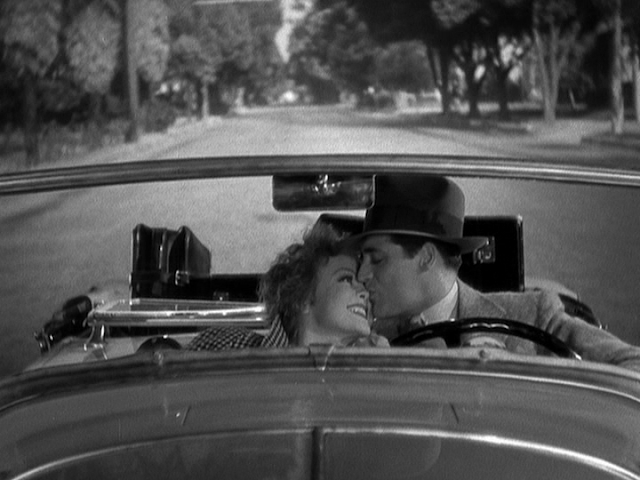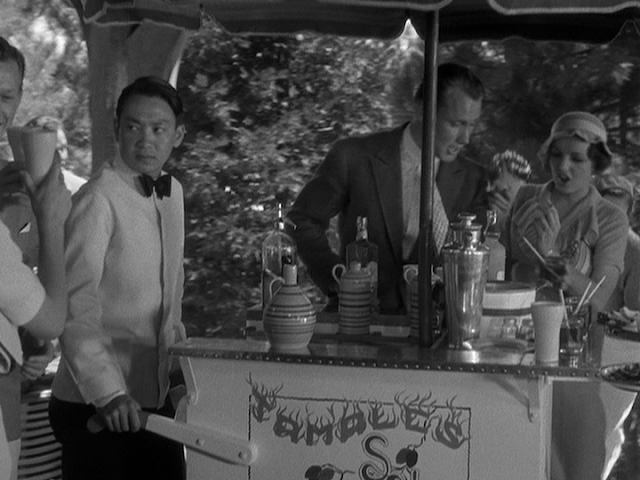The Black Cat marks the first onscreen pairing of Bela Lugosi (Dracula) and Boris Karloff (Frankenstein). They would go on to make another seven films together between 1934 and 1945. For a deep dive into the careers of these horror icons, I recommend Karina Longworth’s podcast You Must Remember This, where she dedicated six episodes to Karloff and Lugosi.
And there’s so much to unpack in this film, even at the plot level: Revenge! Murder! Satanism! Drugs! Flaying alive! Pseudo-incest! Possible necrophilia! Modernist architecture! (For a movie that runs just over one hour, TBC really does manage to be comprehensively and impressively weird.)
Beyond the story itself, The Black Cat distracted me for HOURS, looking up tidbits on Aleister Crowley, World War I in Hungary, concrete construction methods, and the incredibly varied career of the director, Edgar G. Ulmer. Let’s get cracking!
The plot
The Black Cat opens aboard a train departing from Budapest in the early 1930s. Joan and Peter Alison are setting out, fresh from their wedding, for their honeymoon in Gömbös. They are young, carefree, American — and entirely unprepared for sordid skulduggery set amidst the ruins of the Habsburg empire.Summarizing this story is difficult, because The Black Cat is mostly made up of dense atmospheric visuals, punctuated by moments of plot exposition. I suppose that I could have simply written that the newlyweds are caught between two old enemies in a creepy house; that they become pawns in both a satanic rite and a revenge plot; and that they flee as the house explodes around the two mortal enemies. But it’s the details and textures that make TBC compelling, so we’ll take our time and enjoy ourselves.
Bad news, you two… this is not a romantic comedy. Put the toy cat down, Peter.
Due to a reservation error, Peter and Joan (David Manners and Jaqueline Wells) must share their private compartment with Dr. Vitus Werdegast (Bela Lugosi). He is pleasant enough upon first introductions, but as soon as the newlyweds fall asleep, Werdegast begins to softly caress Joan’s hair, as syrupy music plays in the background.
Nope. Nope. Nope.
Peter wakes, glaring at him, and the doctor begs his indulgence, saying, “Eighteen years ago, I left a girl, so like your lovely wife, to go to war. Kaiser and country, you know. She was my wife.” For some reason, Peter lets this excuse pass, and Joan sleeps on. It’s okay! She doesn’t need to worry her pretty little head about bodily autonomy, anyhow. I fear that this is the beginning of a disturbing trend, my friends.
Werdegast tells Peter that he has spent the past fifteen years in a notorious prison, from which few ever return. He is now on his way to visit an old comrade, Hjalmar Poelzig — who we later learn is responsible for Werdegast’s betrayal and imprisonment. Bela Lugosi puts on one of his excellent creepy faces. He has so many in this movie!
Our new friends are all headed in the same direction, so they share a bus. The driver provides a cheerful bit of background information about the surrounding area, which was the scene of a major battle in WWI: “The ravine down there was piled twelve deep with dead and wounded men. The little river below was swollen. A red, raging torrent of blood.”
His expository duty now fulfilled, the driver promptly loses control of the bus and dies in the crash. This leaves the remaining passengers conveniently stranded near the home of Hjalmar Poelzig, the “friend” of Dr. Werdegast. Joan is injured and unconscious, so Werdegast’s creepy servant carries her. Once they arrive, the doctor treats Joan’s minor injury and administers a sedative.
Poelzig has built an architectural horror on the ruins of Fort Marmorsch. I’m a fan of both Bauhaus and Streamline Moderne buildings, but Poelzig has managed to combine these movements into a monstrous style I like to call “Gothique Moderne.”
Zillow listing reads: “A masterpiece of construction built upon the ruins of
the masterpiece of destruction — a masterpiece of murder.”
Sure to sell quickly!
Meanwhile, in a wonderfully shot moment, we get our first real glimpse of Hjalmar Poelzig, our primary villain. A servant summons him via intercom (art deco, of course!), and the camera pans to the bed: first gauzy curtains, then a glimpse of a sleeping woman, with hair fanning across the pillow, and finally a man rising out of bed. The lighting on this sequence is wonderful, and Karloff’s straight-leg sit up is impressive. There’s a reason it’s a classic horror movie move.
No snark for this sequence. I love it.
Dr. Werdegast then confronts Poelzig, and I wish I could just post whole pages of dialogue and screenshots, because Lugosi and Karloff are delicious together. Werdegast accuses Poelzig of betraying the soldiers of Fort Marmarosch, and leaving them all to be killed or captured by the Russians. “The murderer of 10,000 men returns to the place of his crimes. Those who died were fortunate…. Fifteen years I’ve rotted in the darkness, waiting. Not to kill you — to kill your soul — slow.”
Poelzig also stole Werdegast’s wife, Karin, by telling her that her husband had died in battle. Now Dr. Werdegast has come to find his wife and daughter, and to exact his revenge.
At this tense moment, Peter Alison ambles in to introduce himself and make awkward small talk. He really CANNOT read a room.
When a black cat passes by, Werdegast shrieks and uses one of the throwing knives conveniently at hand. This is not acceptable, even for someone suffering from extreme fear of cats. Also not acceptable: standing calmly by and sipping whiskey. From here on out, I am Team Cat, and everyone else can go to hell.
Also also wik: Why are there so many throwing knives lying around?
Joan appears in the room, in a dreamy state of sedation. While Werdegast and Poelzig look on, she begins to kiss Peter passionately. In an ominously effective shot, we see Poelzig grasp the statuette of a woman as the lovers embrace in the background.
Poelzig, you creepy pervert!
Dr. Werdegast actually has to remind Peter that it would be a bad idea to consummate his wedding night with his injured, drugged bride. “Excuse my presumption, but I must emphasize the extreme importance of Mrs. Alison having complete quiet.... Rest is the important thing.” When Werdegast is the one reminding you to keep your hands to yourself, you know it's important.
After Peter tucks himself into bed (alone) and turns off his night light via remote control (neat!), we are treated to a little tour of the premises. Poelzig cradles his (not-dead) cat, and strolls around his gallery of dead women in glass cases. They’ve all been perfectly preserved, and are suspended upright for maximum creepiness.
This is just.... I mean.... *shudder*
There’s no dialogue — just ominous shadows and string music. Poelzig then deposits the cat in the next room, and deliberately closes the door behind him. I do not want to think about what Poelzig is doing amongst his collection, once he is alone.
Some time later, Poelzig agrees to take Werdegast to see his wife. They descend down the spiral staircase to the remains of Fort Marmorsch, which is where Karin is suspended amongst the other dead women.
“Do you see Vitus? I have cared for her tenderly and well. You will find her almost as beautiful as when you last saw her. She died two years after the war…. Is she not beautiful? I wanted to have her beauty always. I loved her too, Vitus.”
Please note! Despite what Werdegast told Peter in the train, Joan and Karin
do not look at all alike. That was just an excuse for gratuitous hair stroking.
Before he can kill Poelzig, Werdegast is overcome by the return of the black cat, which causes him to collapse in despair. Poelzig soothes his former friend by acknowledging their mutual pain and proposing “a little game of death” once Joan and Peter are gone. These guys certainly know how to have fun.
When Poelzig finally returns to his bedroom, the woman in bed asks about all the hubbub. We get a disturbing point-of-view shot of Poelzig hypnotizing her until she sleeps again. He says, “I want you to stay in this room all day tomorrow, Karin. You are the very core and meaning of my life. No one shall take you from me. Not even Vitus. Not even your father.”
Again: Nope. Nope. Nope.
And then Poelzig settles down for a little bedtime reading, about the Rites of Lucifer: “In the night, in the dark of the moon, the High Priest assembles his disciples for the sacrifice. The chosen maiden is garbed in white….”
Well. This doesn’t bode well for the still-virginal Joan. As Peter said, they should have just gone to Niagara Falls.
In the morning, Joan can’t remember the events of the previous night — but she can see that both Werdegast and Poelzig are giving off some seriously creepy vibes.
These two are unsettling, but still more interesting than that milquetoast, Peter.
While Peter and Joan are trying to figure out how to leave their unpleasant host, Poelzig and Werdegast settle down for a little game of chess. The stakes are the young couple — specifically Joan. If Werdegast wins, the newlyweds are free to go; if Poelzig wins, he can keep Joan for use in the ceremonial rites that night. And, presumably, whatever comes after.
Poelzig caressing the queen chess piece as he contemplates Joan’s fate.
Really, it’s the little details that make this movie so chilling.
Peter tries to make arrangements to leave, but his attempts are thwarted, because the phone is dead. Poelzig smiles ghoulishly, saying, “Do you hear that Vitus? The phone is dead. Even the phone is dead.” I love you, Boris Karloff!
Boris is most disturbing when he is smiling.
Poelzig has won the chess match, and the newlyweds are locked up separately. Werdegast promises Joan that he will try to help her escape the Rites of Lucifer, if she will only trust him. I wish I could say that Joan has better options, or that she has shown some shred of gumption… but honestly, she has spent most of the movie helpless or unconscious.
The same goes for Karin — who at least has the excuse of having being hypnotized by her stepfather/husband. Oh dear.
Karin drifts into the room where Joan is imprisoned — and their brief conversation is not going to be enough to pass the Bechdel Test. But it does give Joan an opportunity to tell Karin that her father is actually alive, and in the house. Poelzig's arrival breaks up this meeting. Karin returns to her own room with distressing obedience, and then we hear her screams after Poelzig joins her. This, to me, is one of the most disturbing moments of the whole movie.
I wish Karin had a chance to make a break for it, too.
Night descends, and Poelzig’s guests begin to arrive for the Rites of Lucifer. They gather in the ritual space, while another group of female acolytes force Joan into some sort of ceremonial gown, which they are also wearing. It’s quite ugly, with puffed organza sleeves and ribbon trim that outlines breasts and lower abdomen. No wonder Joan faints as soon as she is dragged up onto the dais.
This is just a really, really awful look.
Before the ritual can really get going, one of the participants screams for no apparent reason. In the confusion, Werdegast and his servant spirit Joan away into the lower reaches of the old fort. Joan tells Werdegast the truth about his daughter, but it is already too late. He soon finds Karin's lifeless body in the embalming room.
There are many scuffles between different people in the last few minutes of the movie, but the end result is that Werdegast manacles Poelzig to a rack before flaying him alive. Even in shadowy silhouette, this is a dreadful scene, especially with the sound of Poelzig’s moans and shrieks.
You can really see the influence of German Expressionist horror films
in the slanting shadows and contorted hand in close-up. Yay!
Joan and Peter flee the scene safely — although Joan’s skirt rips away conveniently as they run. Because this is the last chance for anyone to show a little leg, and it’s the pre-code era.
That's an awfully clean tear, Joan. It's almost like someone planned it ahead of time. Although I'm not sure they meant to show your underwear.
“It’s the red switch, isn’t it Hjalmar? The red switch ignites the dynamite. Five minutes, and Marmaros, you and I, and your rotten cult will be no more. It’s been a good game.”
This is the last time I let a vengeful psychologist plan Game Night.
The film ends with Joan and Peter safely aboard a train, on their way back to Budapest. Peter is reading a newspaper, which contains a generally positive review for his new mystery novel, Triple Murder. The reviewer writes: “We feel, however, that Mr. Alison has, in a sense, overstepped the bounds of the matter of credibility. These things would never, but with a further stretch of the imagination, actually happen. We could wish that Mr. Alison would confine himself to the possible instead of letting his melodramatic imagination run away with him.” Peter and Joan look at each other in bemusement, as if to say, “If they only knew!” The End.
This is the way the movie ends. Not with a bang, but with a snicker.
The tumultuous career of Edgar G. Ulmer
The Black Cat's director and co-writer was Edgar G. Ulmer, an émigré from Vienna. Ulmer had designed sets for Max Reinhardt's theater, and apprenticed under the great F.W. Murnau. He co-directed 1929's Menschen am Sonntag (People on Sunday), a naturalistic film that is about as different from TBC as possible.
Although he began his American film career at a major studio (Universal), most of his subsequent films were produced through the low budget “poverty row” studios. The Black Cat was not beloved by contemporary critics, but it did make a very respectable profit for Universal. Ulmer's black-balling was partially due to the shocking content of TBC, but also because of enemies he made while making it. Ulmer fell in love with Shirley Kassler, who was already married to the nephew of Carl Laemmle (head of Universal). Edgar and Shirley Ulmer would go on to have a long and successful marriage, even though his film career never fully recovered.
Today, Ulmer is a favorite of film critics and historians as an "underground auteur." His movies ranged in genre from film noir (1945's Detour), to “ethnic” films performed in Yiddish, to westerns, and beyond. He even made a short film about tuberculosis, combining live-action and animation. Goodbye Mr. Germ (1940) features an eccentric scientist who invents a radio that allows him to converse with a TB bacterium. His laboratory menagerie lives in miniature houses, including a tiny streamline moderne bungalow for the mice:
Which mouse is Poelzig, and which one is Werdegast?
It's a shame that recognition for Ulmer's work didn't develop until after his death in 1972. However, Ulmer's daughter has been active in preserving his films and legacy.
Censorship and the invisible movie
Even in the pre-code era of daring films, the studios still regulated content. This was especially the case with The Black Cat, which was reportedly even more depraved in the first version submitted by Ulmer. Universal insisted on several plot revisions, as well as some reshoots. Presumably, the hints of incest, necrophilia, and torture that survived are all that remain of even more explicit content.As a result of these last minute changes, The Black Cat loses some of its plot cohesion, but gains a dreamy, ominous atmosphere. There is a film that we can almost see lurking in the 65 minutes of The Black Cat. When characters behave ambivalently, or a scene seems to end abruptly, I suspect that we are seeing traces of a story that resists such revisions.
Vitus Werdegast, for example: he veers between noble and sinister, and I doubt that his character was meant to be 'good' all along. Poelzig notices that Werdegast is 'interested' in Joan, and his motives may not be entirely pure.
Joan is another character who seems like she might have done more than faint a lot. When she is in a trance-like state — ‘mediumistic,’ according to Werdegast — she speaks and moves differently than usual. Joan seems as though she could be susceptible to transgressions that we never get to see. More’s the pity!
The Rites of Lucifer and Aleister Crowley
Let’s get satanic!
Some sources I’ve read suggest that Poelzig’s satanism was inspired by Aleister Crowley, the well-known occultist and “wickedest man in the world.” Certainly, Crowley was one of the most prominent occultists at the time, and had an undeniable talent for self-promotion.
In the late 1920s and 1930s, Crowley was frequently featured in books and newspapers as a practitioner of ritual “magick.” Rumors about his activities accused him of all sorts of sexual perversion, blasphemy, and animal sacrifice.
Hiya, Uncle Al!
Now, I have at least a moderate familiarity with Crowley and the organization most influenced by him, the Ordo Templi Orientis (OTO). I’ve had a number of friends who have been initiated, and I have attended the Gnostic Mass and other rituals. It should be a relief to some (and a disappointment to others) that Crowley’s legacy is not nearly as depraved as rumored. There’s been a distinct absence of human or animal sacrifice, and negligible public sex. I'm okay with that.
Of course, my first question about the Poelzig/Crowley connection had to do with modernist architecture. (What? Your first thought isn’t about Bauhaus? Shame on you!)
Crowley was by no means proponent of avant garde architecture, but I think that Ulmer introduced this attribute intentionally. In the early 1930s, Crowley engaged in a number of libel lawsuit against books that featured him, such as The Laughing Torso by Nina Hamnett. Poelzig’s modernist sensibilities may have served as a form of plausible deniability from any lawsuits that Crowley decided to initiate for fun or profit.
Poelzig’s cult doesn’t get very far into the Rite of Lucifer before it is interrupted, so we don’t know exactly what was in store for Joan. Maybe a little ritual defilement, maybe a little human sacrifice, maybe a little of everything. But since it surely continued with The Black Cat’s theme of disregarding women’s autonomy over their own bodies, I’m not sorry we miss it.
Joan did NOT sign up for this nonsense, especially the ugly dress.
Also, no ritual is complete without some ominous Latin or other ancient language. Poelzig somberly intones Latin phrases to really get the dread flowing. Latin scholars (or people with internet access) will know, however, that he is actually saying, “With a grain of salt. A brave man may fall but he cannot yield. To err is human. The wolf may change his skin but not his nature. Truth is mighty and will prevail. External actions show internal secrets….”
Fun with Gothique Moderne
The character Hjalmar Poelzig was also inspired by real-life architect Hans Poelzig, who reportedly mentored the film's director, Edgar G. Ullmer. In addition to traditional architecture, Hans Poelzig also created the set design for the German Expressionist film Der Golem. You probably need more German Expressionism in your life, and just don’t know it. I’m here to help!The sets of The Black Cat are practically a character on their own. The house features geometric lines, metallic accents, and art-deco tchotchkes aplenty. Peter remarks, “So this guy Poelzig’s a great architect…. If I wanted to build a nice, cozy, unpretentious insane asylum, he’d be the man for it.” Peter hasn’t even seen the embalming room yet!
The staircase is nice, but the accent wall is awfully busy.
If anything, the remains of the fortress look even more modern by 21st century standards. The walls are all board-formed concrete, currently rather chic, at least according to Pinterest boards. In the early 20th century, though, it was a hallmark of functional building techniques, particularly suited to gloomy underground fortresses.
Board-formed concrete + spiral staircase + dramatic lighting = your new dream home!
Modernism atop the ruins of Mitteleuropa
Plenty of horror films, especially the classics, are heavy on the cobwebs and crumbling castles. However, The Black Cat manages to infuse horror into the fresh paint and clean lines of Bauhaus aesthetics. In fact, TBC is very much a film about Germany and the Austria-Hungary region after World War I.This post is not the place for an extended analysis of Modernity and the WWI, even if I were qualified to do so. For a little light reading, I recommend Rites of Spring: The Great War and the Birth of the Modern Age by Modris Eksteins.
But Poelzig gives a monologue to Werdegast midway through the film, highlighting these themes of loss, destruction, and nihilism.
Come, Vitus, are we men or are we children? Of what use are all these melodramatic gestures? You say your soul was killed and that you have been dead all these years. And what of me? Did we not both die here in Marmorus fifteen years ago? Are we any the less victims of the war than those whose bodies were torn asunder? Are we not both the living dead? And now you come to me, playing at being an avenging angel — childishly thirsting for my blood. We understand each other too well. We know too much of life. We shall play a little game, Vitus. A game of death, if you like….As the Rites of Lucifer begin, we see a montage of faces. Ulmer wrote in the original screenplay, “They are to be as aberrant as possible… a stable of misfits, members of a decadent aristocracy of the countryside.” It’s no great surprise that The Black Cat was banned by the Austrian State Board of Censorship.
You know how much I enjoy a montage of creepy faces.
Enter the Americans
Peter and Joan have somehow stumbled into this decadent European quagmire. Peter is especially clueless about the currents of tension between Werdegast and Poelzig. He’s a cheerful, no-nonsense guy — and so very American. He can't quite put his finger on the unusual atmosphere of Poelzig's home, probably because it did not come from a Sears-Roebuck catalog. Werdegast suggests helpfully that death is what Peter senses.
"What kind of air freshener do you use? It smells like history and despair.
It's so quaint!"
In the rare moments when Joan and Peter are not being menaced by continental villains, they laugh about how hungry they are, or at the difficulty of pronouncing European names. “I don't like Mr. Pigslow, or whatever his name is,” pouts Joan. The couple break into chuckles as they try to pronounce “Poelzig.” [I mean, it's not an easy name. The 'oe' is the equivalent of a German umlaut, which means the name sounds almost like “Perrrrl-zig.”)
This scene is followed by an odd bit of comic relief mid-way through the film, when a pair of gendarmes arrive to inquire about the bus accident. They are jolly Hungarians (played by Italian-Americans, however), and they argue over the charms of their home villages. Upon learning that the American newlyweds are on their honeymoon, they squabble over whether Gömbös or Pisthyan makes a better vacation destination. This is the Europe that Americans expect — charming, quaint, and eager to entertain wealthy tourists.
The Abbott and Costello of the Carpathian mountains
To me, The Black Cat provides an interesting contrast between ideas of America and Europe, albeit in very broad strokes. Peter may be naive, but he and Joan also manage to smash their way out of the fortress unscathed — while the others are destroyed by the explosives undermining the structure.
Why I am no longer speaking to Edgar Allen Poe, and why I have developed doubts about Dr. Werdegast.
The Black Cat was advertised as “suggested by” Edgar Allen Poe’s short story of the same name. Ulmer admitted later that this was a marketing gimmick, and that the movie plot had nothing in common with the original story.As part of due diligence, I read Poe’s story. I know that it is supposed to be horrifying, but I really, really hated it. I just can’t get behind the mistreatment of cats, even in a fictional setting. The narrator kills his cat, and later his wife; his crimes are revealed to the police by the yowling of another walled-up cat.
There’s not much similarity to the film, but the tale did stir some suspicions of Dr. Werdegast for me. Poe’s narrator develops a horror of black cats after torturing and killing his own once-beloved cat. Is there some backstory to Werdegast's ailurophobia? Did it develop after mistreating a cat? If so, I wash my hands of him. I mean, even Joseph Breen had the sense to forbid any suggestion of animal cruelty in his editing directives.
YOU GET NOTHING. GOOD DAY SIR!
In conclusion...
This is a ridiculously long post, and I still feel like I only skimmed over the interesting bits. I love The Black Cat, even though it's packed with perverse weirdness. I love it BECAUSE it's packed with perverse weirdness.
MEOW!
Selected references:
Herzogenrath, Bernd, Ulmer Cipes, Arianné, & Bogdanovich, Peter. (2009). The Films of Edgar G. Ulmer. Lanham, MD: Scarecrow.
Isenberg, Noah William. Edgar G. Ulmer : a Filmmaker at the Margins. Berkeley : University of California Press, 2013.
Ulmer, Edgar G. Goodbye, Mr. Germ. 1940. https://archive.org/details/goodbye_mr_germ_1940
100th Monkey Press (articles by and about Aleister Crowley).
https://www.100thmonkeypress.com/biblio/acrowley/articles/articles.htm



























